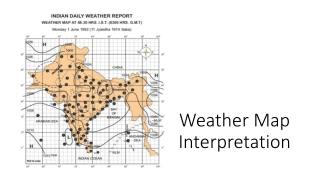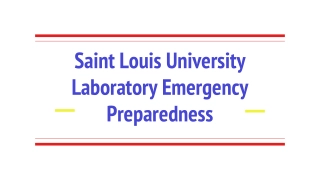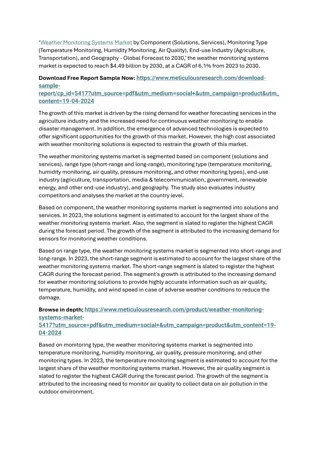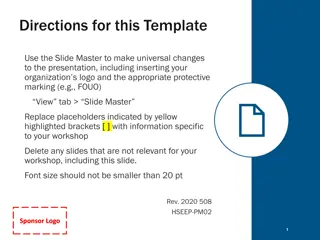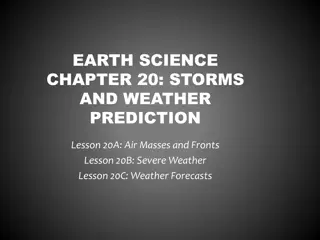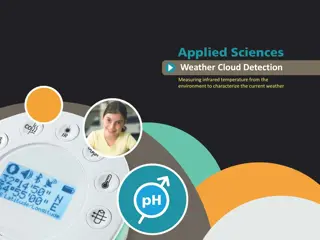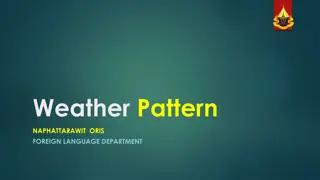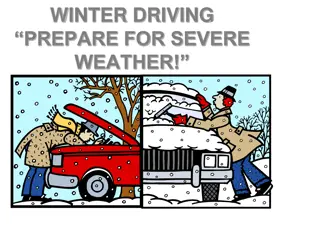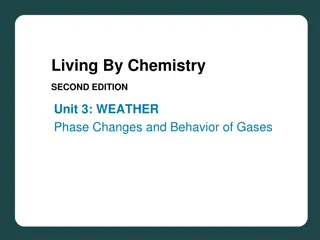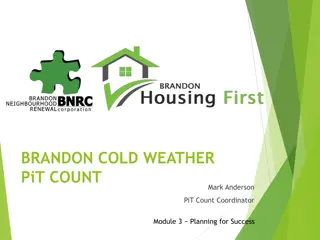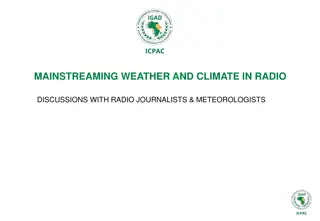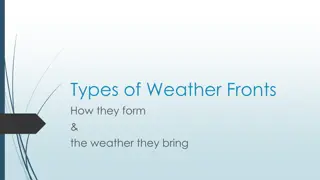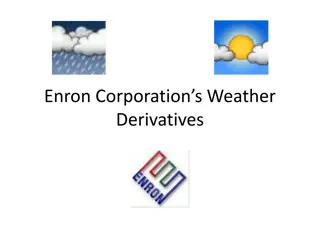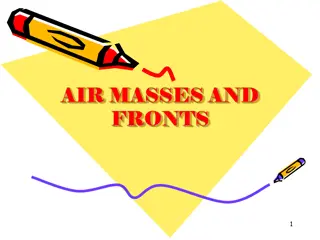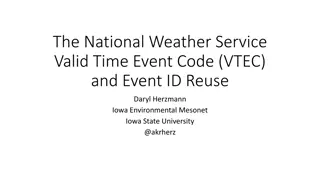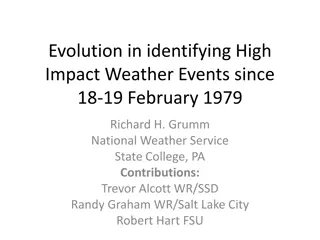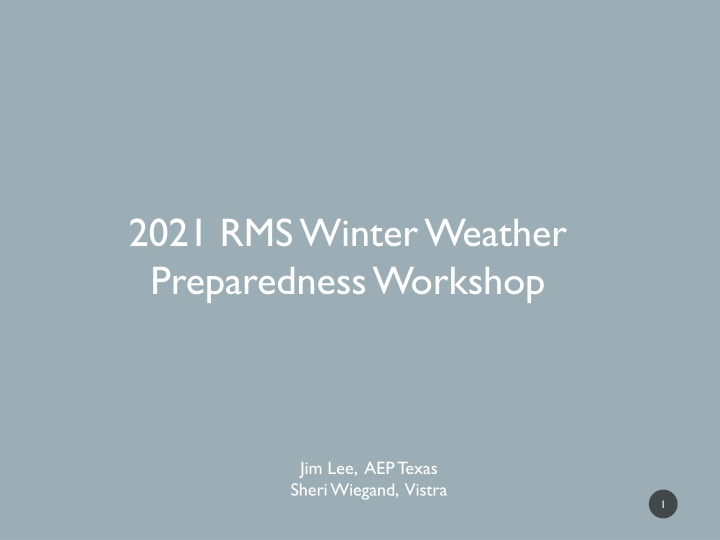
ERCOT Winter Weather Preparedness Workshop Insights
Explore the detailed agenda, scope, and purpose of the ERCOT Winter Weather Preparedness Workshop focusing on ERCOT EEA Operations, Critical Load Applications, Outage Procedures, and more. Gain valuable insights into emergency operation deployment and grid reliability to navigate major weather events effectively.
Download Presentation

Please find below an Image/Link to download the presentation.
The content on the website is provided AS IS for your information and personal use only. It may not be sold, licensed, or shared on other websites without obtaining consent from the author. If you encounter any issues during the download, it is possible that the publisher has removed the file from their server.
You are allowed to download the files provided on this website for personal or commercial use, subject to the condition that they are used lawfully. All files are the property of their respective owners.
The content on the website is provided AS IS for your information and personal use only. It may not be sold, licensed, or shared on other websites without obtaining consent from the author.
E N D
Presentation Transcript
2021 RMS Winter Weather Preparedness Workshop Jim Lee, AEP Texas Sheri Wiegand, Vistra 1
Agenda: 1. Purpose & Scope 2. ERCOT EEA Operations 3. TDU Evaluation and Approval of Critical Care/Chronic Condition & Critical Load applications 4. Review of Widespread Prolonged Outage Procedures & TDSP EOP Procedures 5. Overview of Mass Transition Processes, Timeline & Communication 6. Q&A 2
SCOPE & PURPOSE Overview of the processes and procedures established for the ERCOT Retail market and its Market Participants, and suggestions for preparation in the events of a major weather event which may necessitate emergency operation deployment/activation in order to preserve the integrity and reliability of the ERCOT grid. Highlighting applicable PUCT substantive rules, ERCOT Nodal Protocols, Retail operational practices, and Market Participant communications utilized before, during, and after emergency situations including, but not limited to: ERCOT Energy Emergency Alert (EEA) operations, critical care/critical load processes, TDSP outage management and communications, handling of AMS data during prolonged widespread outages, and overview of the Mass Transition process. These workshops will be held twice a year and Market Participants are encouraged to fully review referenced PUCT Rules and ERCOT Protocols and Market Guides for a full understanding of applicable rules and protocols. 3
ERCOT ENERGY EMERGENCY ALERT (EEA) OPERATIONS 4
ERCOT ROLE & RESPONSIBILITIES 5
NODAL PROTOCOL 6.5.9, EMERGENCY OPERATIONS NP 6.5.9.3(2) Communication under Emergency Conditions The type of communication ERCOT issues is determined primarily on the basis of the time available for the market to respond before an Emergency Condition occurs. The timing of these communications could range from days in advance to immediate. If there is insufficient time to allow the market to react, ERCOT may bypass one or more of the communication steps. 1) Operating Condition Notice (OCN) [NP 6.5.9.3.1] 2) Advance Action Notice (AAN) [NP 6.5.9.3.1.1] 3) Advisory [NP 6.5.9.3.2] 4) Watch [NP 6.5.9.3.3] 5) Emergency Notice [NP 6.5.9.3.4] 9
NODAL PROTOCOL 6.5.9.3.4, EMERGENCY NOTICE (2) ERCOT shall issue an Emergency Notice for one or both of the following reasons: (a) ERCOT cannot maintain minimum reliability standards (for reasons including fuel shortages) during the Operating Period using every Resource practicably obtainable from the market; or (b) Immediate action cannot be taken to avoid or relieve a Transmission Element operating above its Emergency Rating. (3) The actions ERCOT takes during an Emergency Condition depend on the nature and severity of the situation. (5) If the Emergency Condition is the result of a transmission problem, ERCOT shall act immediately to return the ERCOT System to a reliable condition, including instructing Resources to change output, curtailing any remaining DC Tie Load, and instructing TSPs or DSPs to drop Load. 10
TSP/DSP ROLE & RESPONSIBILITIES 11
ERCOT will declare EEA levels according to available Physical Responsive Capability (PRC) MW reserves, and will take the steps outlined in NOG 4.5.3.3, EEA Levels, to maintain steady state system frequency near 60 Hz and restore PRC appropriate for each EEA level. When the TSP/DSP receives Energy Emergency Alert (EEA) Load Shedding instructions from ERCOT, the TSP/DSP s responsibility is to perform all necessary actions as prescribed in the ERCOT Nodal Operating Guides (NOG) Section 4, Emergency Operations within the timelines as specified throughout this section. Section 4: Emergency Operation 12
EXAMPLE: TIMING OF ERCOT INSTRUCTIONS TO TSP/DSP Initial Instructions: ERCOT will instruct TSP/DSPs to shed X MWs on the Distribution System within 30 minutes. Follow-up Instructions: After completing the initial 30 minute instruction, ERCOT operator may continue with further instructions if the PRC has not been restored. Follow up instructions can range from ten (10) to thirty (30) minute durations with specific instructions for TSP/DSPs to continue load shedding procedures until ERCOT declares the EEA event has been terminated. Note: TDSPs rotate outages on the Distribution system only. The Transmission system is not subject to rotating outages. 13
NODAL OPERATING GUIDE 4.5.3.4, LOAD SHED OBLIGATION 2020 Total Transmission Operator Load (%MW) 8.23 5.11 0.36 0.51 24.78 3.55 0.28 0.76 0.62 6.47 0.48 0.15 0.38 0.07 6.05 36.16 Transmission Operator AEP Texas Central Company Brazos Electric Power Cooperative Inc. Brownsville Public Utilities Board Bryan Texas Utilities CenterPoint Energy Houston Electric LLC City of Austin DBA Austin Energy City of College Station City of Garland City of Lubbock CPS Energy (San Antonio) Denton Municipal Electric GEUS (Greenville) Golden Spread Electric Cooperative Inc. Lamar County Electric Cooperative Inc.* LCRA Transmission Services Corporation Oncor Electric Delivery Company LLC Rayburn Country Electric Cooperative Inc. DBA Rayburn Electric South Texas Electric Cooperative Inc. Texas-New Mexico Power Company 1.38 2.00 2.66 14 ERCOT Total 100.00 * Lamar County Electric Cooperative is a registered TO not on the ERCOT Hotline, City of Garland receives all their calls.
NODAL OPERATING GUIDE 4.5.3.5, EEA TERMINATION (1) ERCOT shall: (a) Continue EEA until sufficient Resources are available to ERCOT to eliminate the shortfall and restore adequate reserves; (b) Restore full reserve requirements (normally 2300 MW); (c) Terminate the levels in reverse order, where practical; (d) Notify each QSE and TO of EEA level termination; and (e) Maintain a stable ERCOT System frequency when restoring Load. (2) QSEs and TOs shall: (a) Implement actions to terminate previous actions as EEA levels are released in accordance with these Operating Guides; (b) Notify represented Market Participants of EEA levels changes; (c) Report back to the ERCOT System Operator when each level is accomplished; and (d) Loads will be restored when specifically authorized by the ERCOT. 16
ADDITIONAL ERCOT COMMUNICATIONS INFORMATION Tips for Conservation: http://www.ercot.com/content/wcm/lists/219692/Energy_Conservation_FINAL_8.4.2021.pdf ERCOT EEA Communications Matrix: http://www.ercot.com/content/wcm/lists/197394/ERCOT_Energy_Emergency_Alert_Communic ations_Matrix_October_2020.pdf ERCOT EEA Overview: http://www.ercot.com/content/wcm/lists/219692/2021_EEA_Overview_Final.pdf ERCOT Emergency Operations & Communications Web-Based Training http://www.ercot.com/services/training/course/159883 17
ERCOT ENERGY EMERGENCY ALERTS (EEA) MATRIX 18
Questions? 19
TDU EVALUATION AND APPROVAL OF CRITICAL CARE, CHRONIC CONDITION & CRITICAL LOAD APPLICATIONS 20
FOR YOUR REFERENCE PUCT Subst. Rule 25.497 Critical Load Industrial Customers, Critical Load Public Safety Customers, Critical Care Residential Customers, and Chronic Condition Residential Customers 21
CRITICAL LOAD, CRITICAL CARE, CHRONIC CONDITION A complete step-by-step procedure for obtaining Critical Care Residential Customer or Chronic Condition Residential Customer designation is provided in 25.497(e). The TDU is responsible for evaluation and approval of Critical Care, Chronic Condition and Critical Load status through the submittal of the PUCT-approved form, which is posted on the PUCT website and on each TDU s website. Following TDU evaluation and approval, the TDU will update ESI ID attributes to reflect the Critical Care, Chronic Condition or Critical Load status via 814_20 ESIID Maintenance transaction through ERCOT, which is passed to the CR of Record. 22
CRITICAL LOAD, CRITICAL CARE, CHRONIC CONDITION (c) Benefits for Critical Load Public Safety Customers, Critical Load Industrial Customers, Critical Care Residential Customers, and Chronic Condition Residential Customers. (1) A Critical Load Public Safety Customer or a Critical Load Industrial Customer qualifies for notifications of interruptions or suspensions of service as provided in Sections 4.2.5, 5.2.5, and 5.3.7.1 of the TDU s tariff for retail delivery service. (2) A Critical Care Residential Customer or Chronic Condition Residential Customer qualifies for notification of interruptions or suspensions of service, as provided in Sections 4.2.5, 5.2.5, and 5.3.7.1, and for Critical Care Residential Customers protections against suspension or disconnection, as provided in Section 5.3.7.4(1)(D) and (E), of the TDU s tariff for retail delivery service. (3) A Critical Care Residential Customer or Chronic Condition Residential Customer is also eligible for certain protections as described in 25.483 (relating to Disconnection of Service). (4) Designation as a Critical Load Customer, Critical Care Residential Customer, or Chronic Condition Residential Customer does not guarantee the uninterrupted supply of electricity. 23
Questions? 24
TDSP AMS DATA PRACTICES & TDSP EOP PROCEDURES 25
Questions? 26
OVERVIEW OF MASS TRANSITION PROCESS, TIMELINE, AND COMMUNICATIONS Note: Mass Transition events are not always tied to an ERCOT EEA event or a TDSP EOP event.
Timeline for Initiation of a Mass Transition Project Coordination Call 867_02s from TDSP to ERCOT. 814_04s from TDSP to ERCOT. 814_11s from ERCOT to Losing CR. 814_14s from ERCOT to POLR and/or Designated CRs. Customer billing information sent by ERCOT to POLR and/or Designated CRs and affected TDSP(s). ERCOT sends PUCT mandated notifcations to Customers Project Coordination Call TDSP sends to ERCOT Final 867_03s and ERCOT forwards to Losing CR. TDSP sends 867_04s to ERCOT and ERCOT forwards to POLR and/or Designated CRs. Mass Transition completes at ERCOT. Notification Date Project Coordination Call Default confirmed by ERCOT legal Mass Transition process: ESI ID allocations & lists are generated and sent to POLR and/or Designated CR and affected TDSPs by ERCOT 814_03s sent by ERCOT requesting Mass Transition Date. ERCOT requests Customer Billing Contact Information from Defaulting CR. Initial Notification sent Initial Project Coordination Call scheduled Mass Transition Date If default is on a Business Day before a weekend or ERCOT holiday, initial project coordination call to occur on same Business Day Project Coordination Call TDSP performs meter reads (actuals or estimates) for Mass Transition Date. Calendar Day 0 Calendar Day -1 Calendar Day 1 Calendar Day 2 Calendar Day 3 & 4 Calendar Day 5 28
MASS TRANSITION TIMELINE Mass Transition Date Day 2 Day 3 / Day 4 / Day 5 Notification Date Day 0 Day 1 ERCOT provides notice of Mass Transition event to impacted CRs, TDSPs, and PUCT Project Coordination Call 1 Project Coordination Call 2 Project Coordination Call 3 Where applicable, TDSPs will send 867_04 and/or 867_03F for SWI/MVI/Drop to POLR transactions completed ERCOT begins Customer outreach to inform of POLR event (postcard/email/phone/t ext) ERCOT forwards any competitive 814_03 SWI or MVI to TDSP Notice before 3pm CT: Proj. Coord. call held by 5pm. ERCOT sends 814_03 TS Drop to POLR transactions to TDSPs with an effective date of two calendar days out ( Mass Transition Date ) Notice after 3pm CT: Proj. Coord. call held next morning. TDSP executes competitive 814_03 SWI or MVI if rec d by 7pm CPT ERCOT forwards any competitive 814_03 SWI or MVI to TDSP TDSP schedules Drop to POLR as requested by ERCOT Once a default is confirmed, ERCOT provides impacted TDSPs with the Defaulting CR DUNS to prepare systems for a Mass Transition event Beginning 7:01pm CPT, TDSPs execute the remaining population of Drop to POLR transactions (if SWI/MVI hasn t been already executed by TDSP or Cancelled by ERCOT) TDSP executes SWI or MVI in lieu of scheduled Drop to POLR; ERCOT sends Cancel for Drop to POLR Default CR provides CBCI file to ERCOT IMPORTANT NOTE: Per PUCT Subst. R 25.43, if a Mass Transition Drop to POLR s Effective Date falls on a Sunday or Holiday, non-AMS Operational Day rules and non-Business day rules shall apply. Meaning, no competitive 814_01 Switch or 814_16 Move- In will be scheduled for the same Effective Date, thereby only the Drop to POLR will effectuate. 29
MARKET COMMUNICATIONS OF MASS TRANSITION EVENT
ERCOT MARKET COMMUNICATIONS PUCT Subst. Rule 25.43(u) Market Notice of Transition to POLR Service ERCOT shall notify all affected Market Participants and the Retail Market Subcommittee (RMS) email listserv of a mass transition event within the same day of an initial mass-transition call after the call has taken place. The notification shall include the exiting REP s name, total number of ESI IDs, and estimated load. Market Participant suggested steps for Mass Transition event readiness: 1. Ensure Authorized Representative (AR) and Back-up AR contacts are up-to-date via ERCOT Notice of Change of Information (NCI) form for timely ERCOT communications regarding: Notification of Mass Transition event Receipt of ESI ID file 2. ERCOT Initiated MarkeTrak issues may be received by any impacted REPs with in-flight transactions involving exiting CR(s) 3. Customer Billing and Contact Information (CBCI) file will be received via NAESB 4. Mass Transition Web-Based Training for familiarity of Mass Transition process 31
CUSTOMER COMMUNICATIONS (PRE-TRANSITION) PUCT Subst. Rule 25.43(t) - Notice of transition to POLR service to customers When a customer is moved to POLR service, the customer shall be provided notice of the transition by ERCOT, the REP transitioning the customer, and the POLR provider. The ERCOT notice shall be provided within two days of the time ERCOT and the transitioning REP know that the customer shall be transitioned and customer contact information is available. If ERCOT cannot provide notice to customers within two days, it shall provide notice as soon as practicable. (1) ERCOT notice methods shall include a post-card, containing the official commission seal with language and format approved by the commission. ERCOT shall notify transitioned customers with an automated phone-call and email to the extent the information to contact the customer is available pursuant to subsection (p)(6) of this section. ERCOT shall study the effectiveness of the notice methods used and report the results to the commission. 32
Questions? 33

